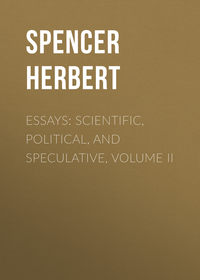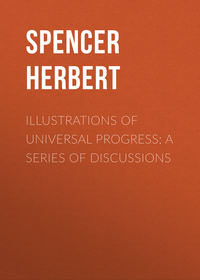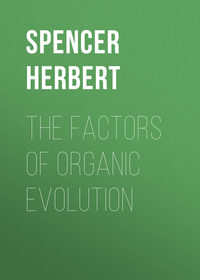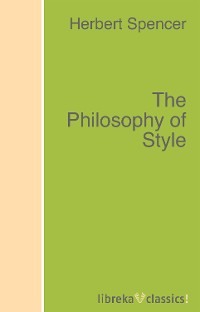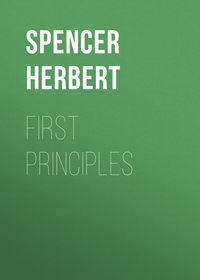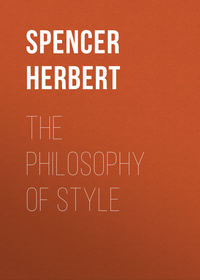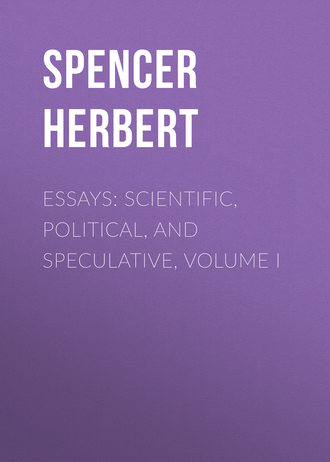 полная версия
полная версияEssays: Scientific, Political, and Speculative, Volume I
The instability thus variously illustrated becomes still more manifest if we consider its rationale. It is consequent on the fact that the several parts of any homogeneous mass are necessarily exposed to different forces – forces which differ either in their kinds or amounts; and being exposed to different forces they are of necessity differently modified. The relations of outside and inside, and of comparative nearness to neighbouring sources of influence, imply the reception of influences which are unlike in quantity or quality or both; and it follows that unlike changes will be wrought in the parts dissimilarly acted upon. The unstable equilibrium of any homogeneous aggregate can thus be shown both inductively and deductively.
And now let us consider the bearing of this general truth on the evolution of organisms. The germ of a plant or animal is one of these homogeneous aggregates – relatively homogeneous if not absolutely so – whose equilibrium is unstable. But it has not simply the ordinary instability of homogeneous aggregates: it has something more. For it consists of units which are themselves specially characterized by instability. The constituent molecules of organic matter are distinguished by the feebleness of the affinities which hold their component elements together. They are extremely sensitive to heat, light, electricity, and the chemical actions of foreign elements; that is, they are peculiarly liable to be modified by disturbing forces. Hence then it follows, a priori, that a homogeneous aggregate of these unstable molecules will have an excessive tendency to lose its equilibrium. It will have a quite special liability to lapse into a non-homogeneous state. It will rapidly gravitate towards heterogeneity.
Moreover, the process must repeat itself in each of the subordinate groups of organic units which are differentiated by the modifying forces. Each of these subordinate groups, like the original group, must gradually, in obedience to the influences acting on it, lose its balance of parts – must pass from a uniform into a multiform state. And so on continuously.
Thus, starting from the general laws of things, and the known chemical attributes of organic matter, we may conclude deductively that the homogeneous germs of organisms have a peculiar proclivity towards a non-homogeneous state; which may be either the state we call decomposition, or the state we call organization.
At present we have reached a conclusion only of the most general nature. We merely learn that some kind of heterogeneity is inevitable; but as yet there is nothing to tell us what kind. Besides that orderly heterogeneity which distinguishes organisms, there is the disorderly or chaotic heterogeneity, into which a loose mass of inorganic matter lapses; and at present no reason has been given why the homogeneous germ of a plant or animal should not lapse into the disorderly instead of the orderly heterogeneity. But by pursuing still further the line of argument hitherto followed we shall find a reason.
We have seen that the instability of homogeneous aggregates in general, and of organic ones in particular, is consequent on the various ways and degrees in which their constituent parts are exposed to the disturbing forces brought to bear on them: their parts are differently acted upon, and therefore become different. Manifestly, then, a rationale of the special changes which a germ undergoes, must be sought in the particular relations which its several parts bear to each other and to their environment. However it may be masked, we may suspect the fundamental principle of organization to be, that the many like units forming a germ acquire those kinds and degrees of unlikeness which their respective positions entail.
Take a mass of unorganized but organizable matter – either the body of one of the lowest living forms, or the germ of one of the higher. Consider its circumstances. It is immersed in water or air; or it is contained within a parent organism. Wherever placed, however, its outer and inner parts stand differently related to surrounding existences – nutriment, oxygen, and the various stimuli. But this is not all. Whether it lies quiescent at the bottom of the water, whether it moves through the water preserving some definite attitude, or whether it is in the inside of an adult; it equally results that certain parts of its surface are more directly exposed to surrounding agencies than other parts – in some cases more exposed to light, heat, or oxygen, and in others to the maternal tissues and their contents. The destruction of its original equilibrium is therefore certain. It may take place in one of two ways. Either the disturbing forces may be such as to overbalance the affinities of the organic elements, in which case there results that chaotic heterogeneity known as decomposition; or, as is ordinarily the case, such changes are induced as do not destroy the organic compounds, but only modify them: the parts most exposed to the modifying forces being most modified. Hence result those first differentiations which constitute incipient organization. From the point of view thus reached, suppose we look at a few cases: neglecting for the present all consideration of the tendency to assume the inherited type.
Note first what appear to be exceptions, as the Amœba. In this creature and its allies, the substance of the jelly-like body remains throughout life unorganized – undergoes no permanent differentiations. But this fact, which seems directly opposed to our inference, is really one of the most significant evidences of its truth. For what is the peculiarity of the Rhizopods, exemplified by the Amœba? They undergo perpetual and irregular changes of shape – they show no persistent relations of parts. What lately formed a portion of the interior is now protruded, and, as a temporary limb, is attached to some object it happens to touch. What is now a part of the surface will presently be drawn, along with the atom of nutriment sticking to it, into the centre of the mass. Thus there is an unceasing interchange of places; and the relations of inner and outer have no settled existence. But by the hypothesis, it is only in virtue of their unlike positions with respect to modifying forces, that the originally-like units of a living mass become unlike. We must not therefore expect any established differentiation of parts in creatures which exhibit no established differences of position in their parts.
This negative evidence is borne out by abundant positive evidence. When we turn from these ever-changing specks of living jelly to organisms having unchanging distributions of substance, we find differences of tissue corresponding to differences of relative position. In all the higher Protozoa, as also in the Protophyta, we meet with a fundamental differentiation into cell-membrane and cell-contents, answering to that fundamental contrast of conditions implied by the words outside and inside. And on passing from what are roughly classed as unicellular organisms to the lowest of those which consist of aggregated cells, we equally observe the connexion between structural differences and differences of circumstance. In the sponge, permeated throughout by currents of sea-water, the absence of definite organization corresponds with the absence of definite unlikeness of conditions. In the Thalassicolla of Professor Huxley – a transparent, colourless body, found floating passively at the surface of the sea, and consisting essentially of "a mass of cells united by jelly" – there is displayed a rude structure obviously subordinated to the primary relations of centre and surface: in all of its many and important varieties, the parts exhibit a more or less concentric arrangement.
After this primary modification, by which the outer tissues are differentiated from the inner, the next in order of constancy and importance is that by which some part of the outer tissues is differentiated from the rest; and this corresponds with the almost universal fact that some part of the outer tissues is more directly exposed to certain environing influences than the rest. Here, as before, the apparent exceptions are extremely significant. Some of the lowest vegetable organisms, as the Hematococci and Protococci, evenly imbedded in a mass of mucus, or dispersed through the Arctic snow, display no differentiations of surface: the several parts of the surface being subjected to no definite contrasts of conditions. The Thalassicolla above mentioned, unfixed, and rolled about by the waves, presents all its sides successively to the same agencies; and all its sides are alike. A ciliated sphere like the Volvox has no parts of its periphery unlike other parts; and it is not to be expected that it should have; seeing that as it revolves in all directions, it does not, in traversing the water, permanently expose any part to special conditions. But when we come to creatures that are either fixed, or while moving, severally preserve a definite attitude, we no longer find uniformity of surface. The gemmule of a Zoophyte, which during its locomotive stage is distinguishable only into outer and inner tissues, no sooner takes root than its upper end begins to assume a different structure from its lower. The free-swimming embryo of an aquatic annelid, being ovate and not ciliated all over, moves with one end foremost; and its differentiations proceed in conformity with this contrast of circumstances.
The principle thus displayed in the humbler forms of life, is traceable during the development of the higher; though being here soon masked by the assumption of the hereditary type, it cannot be traced far. Thus the "mulberry-mass" into which a fertilized ovum of a vertebrate animal first resolves itself, soon begins to exhibit a difference between the outer and inner parts answering to the difference of circumstances. The peripheral cells, after reaching a more complete development than the central ones, coalesce into a membrane enclosing the rest; and then the cells lying next to these outer ones become aggregated with them, and increase the thickness of the germinal membrane, while the central cells liquefy. Again, one part of the germinal membrane presently becomes distinguishable as the germinal spot; and without asserting that the cause of this is to be found in the unlike relations which the respective parts of the germinal membrane bear to environing influences, it is clear that we have in these unlike relations an element of disturbance tending to destroy the original homogeneity of the germinal membrane. Further, the germinal membrane by and by divides into two layers, internal and external; the one in contact with the liquefied interior part or yelk, the other exposed to the surrounding fluids: this contrast of circumstances being in obvious correspondence with the contrast of structures which follows it. Once more, the subsequent appearance of the vascular layer between these mucous and serous layers, as they have been named, admits of a like interpretation. And in this and the various complications which now begin to show themselves, we may see coming into play that general law of the multiplication of effects flowing from one cause, to which the increase of heterogeneity was elsewhere ascribed.9
Confining our remarks, as we do, to the most general facts of development, we think that some light is thus thrown on them. That the unstable equilibrium of a homogeneous germ must be destroyed by the unlike exposure of its several units to surrounding influences, is an a priori conclusion. And it seems also to be an a priori conclusion, that the several units thus differently acted upon, must either be decomposed, or must undergo such modifications of nature as may enable them to live in the respective circumstances they are thrown into: in other words —they must either die or become adapted to their conditions. Indeed, we might infer as much without going through the foregoing train of reasoning. The superficial organic units (be they the outer cells of a "mulberry-mass," or be they the outer molecules of an individual cell) must assume the function which their position necessitates; and assuming this function, must acquire such character as performance of it involves. The layer of organic units lying in contact with the yelk must be those through which the yelk is absorbed; and so must be adapted to the absorbent office. On this condition only does the process of organization appear possible. We might almost say that just as some race of animals, which multiplies and spreads into divers regions of the earth, becomes differentiated into several races through the adaptation of each to its conditions of life; so, the originally homogeneous population of cells arising in a fertilized germ-cell, becomes divided into several populations of cells that grow unlike in virtue of the unlikeness of their circumstances.
Moreover, it is to be remarked in further proof of our position, that it finds its clearest and most abundant illustrations where the conditions of the case are the simplest and most general – where the phenomena are the least involved: we mean in the production of individual cells. The structures which presently arise round nuclei in a blastema, and which have in some way been determined by those nuclei as centres of influence, evidently conform to the law; for the parts of the blastema in contact with the nuclei are differently conditioned from the parts not in contact with them. Again, the formation of a membrane round each of the masses of granules into which the endochrome of an alga-cell breaks up, is an instance of analogous kind. And should the recently-asserted fact that cells may arise round vacuoles in a mass of organizable substance, be confirmed, another good example will be furnished; for such portions of substance as bound these vacant spaces are subject to influences unlike those to which other portions of the substance are subject. If then we can most clearly trace this law of modification in these primordial processes, as well as in those more complex but analogous ones exhibited in the early changes of an ovum, we have strong reason for thinking that the law is fundamental.
But, as already more than once hinted, this principle, understood in the simple form here presented, supplies no key to the detailed phenomena of organic development. It fails entirely to explain generic and specific peculiarities; and leaves us equally in the dark respecting those more important distinctions by which families and orders are marked out. Why two ova, similarly exposed in the same pool, should become the one a fish, and the other a reptile, it cannot tell us. That from two different eggs placed under the same hen, should respectively come forth a duckling and a chicken, is a fact not to be accounted for on the hypothesis above developed. Here we are obliged to fall back upon the unexplained principle of hereditary transmission. The capacity possessed by an unorganized germ of unfolding into a complex adult which repeats ancestral traits in minute details, and that even when it has been placed in conditions unlike those of its ancestors, is a capacity impossible for us to understand. That a microscopic portion of seemingly structureless matter should embody an influence of such kind, that the resulting man will in fifty years after become gouty or insane, is a truth which would be incredible were it not daily illustrated. But though the manner in which hereditary likeness, in all its complications, is conveyed, is a mystery passing comprehension, it is quite conceivable that it is conveyed in subordination to the law of adaptation above explained; and we are not without reasons for thinking that it is so. Various facts show that acquired peculiarities resulting from the adaptation of constitution to conditions, are transmissible to offspring. Such acquired peculiarities consist of differences of structure or composition in one or more of the tissues. That is to say, of the aggregate of similar organic units composing a germ, the group going to the formation of a particular tissue, will take on the special character which the adaptation of that tissue to new circumstances had produced in the parents. We know this to be a general law of organic modifications. Further, it is the only law of organic modifications of which we have any evidence.10 It is not impossible then that it is the universal law; comprehending not simply those minor modifications which offspring inherit from recent ancestry, but comprehending also those larger modifications distinctive of species, genus, order, class, which they inherit from antecedent races of organisms. And thus it may be that the law of adaptation is the sole law; presiding not only over the differentiation of any race of organisms into several races, but also over the differentiation of the race of organic units composing a germ, into the many races of organic units composing an adult. So understood, the process gone through by every unfolding organism will consist, partly in the direct adaptation of its elements to their several circumstances, and partly in the assumption of characters resulting from analogous adaptations of the elements of all ancestral organisms.
But our argument does not commit us to any such far-reaching speculation as this; which we introduce simply as suggested by it, not involved. All we are here concerned to show, is, that the deductive method aids us in interpreting some of the more general phenomena of development. That all homogeneous aggregates are in unstable equilibrium is a universal truth, from which is deducible the instability of every organic germ. From the known sensitiveness of organic compounds to chemical, thermal, and other disturbing forces, we further infer the unusual instability of every organic germ – a proneness far beyond that of other homogeneous aggregates to lapse into a heterogeneous state. By the same line of reasoning we are led to the additional inference, that the first divisions into which a germ resolves itself, being severally in a state of unstable equilibrium, are similarly prone to undergo further changes; and so on continuously. Moreover, we have found it to be equally an a priori conclusion, that as, in all other cases, the loss of homogeneity is due to the different degrees and kinds of force brought to bear on the different parts; so, in this case too, difference of circumstances is the primary cause of differentiation. Add to which, that as the several changes undergone by the respective parts thus diversely acted upon, are changes which do not destroy their vital activity, they must be changes which bring that vital activity into subordination to the incident forces – they must be adaptations; and the like must be in some sense true of all the subsequent changes. Thus by deductive reasoning we get some insight into the method of organization. However unable we are, and probably ever shall be, to comprehend the way in which a germ is made to take on the special form of its race, we may yet comprehend the general principles which regulate its first modifications; and, remembering the unity of plan so conspicuous throughout nature, we may suspect that these principles are in some way concerned in succeeding modifications.
A controversy now going on among zoologists, opens yet another field for the application of the deductive method. We believe that the question whether there does or does not exist a necessary correlation among the several parts of an organism is determinable a priori.
Cuvier, who first asserted this necessary correlation, professed to base his restorations of extinct animals upon it. Geoffroy St. Hilaire and De Blainville, from different points of view, contested Cuvier's hypothesis; and the discussion, which has much interest as bearing on paleontology, has been recently revived under a somewhat modified form: Professors Huxley and Owen being respectively the assailant and defender of the hypothesis.
Cuvier says – "Comparative anatomy possesses a principle whose just development is sufficient to dissipate all difficulties; it is that of the correlation of forms in organized beings, by means of which every kind of organized being might, strictly speaking, be recognized by a fragment of any of its parts. Every organized being constitutes a whole, a single and complete system, whose parts mutually correspond and concur by their reciprocal reaction to the same definite end. None of these parts can be changed without affecting the others; and consequently each taken separately, indicates and gives all the rest." He then gives illustrations: arguing that the carnivorous form of tooth necessitating a certain action of the jaw, implies a particular form in its condyles; implies also limbs fit for seizing and holding prey; therefore implies claws, a certain structure of the leg-bones, a certain form of shoulder-blade. Summing up he says, that "the claw, the scapula, the condyle, the femur, and all the other bones, taken separately, will give the tooth or one another; and by commencing with any one, he who had a rational conception of the laws of the organic economy, could reconstruct the whole animal."
It will be seen that the method of restoration here contended for, is based on the alleged physiological necessity of the connexion between these several peculiarities. The argument used is, not that a scapula of a certain shape may be recognized as having belonged to a carnivorous mammal because we always find that carnivorous mammals do possess such scapulas; but the argument is that they must possess them, because carnivorous habits would be impossible without them. And in the above quotation Cuvier asserts that the necessary correlation which he considers so obvious in these cases, exists throughout the system: admitting, however, that in consequence of our limited knowledge of physiology we are unable in many cases to trace this necessary correlation, and are obliged to base our conclusions upon observed coexistences, of which we do not understand the reason, but which we find invariable.
Now Professor Huxley has recently shown that, in the first place, this empirical method, which Cuvier introduces as quite subordinate, and to be used only in aid of the rational method, is really the method which Cuvier habitually employed – the so-called rational method remaining practically a dead letter; and, in the second place, he has shown that Cuvier himself has in several places so far admitted the inapplicability of the rational method, as virtually to surrender it as a method. But more than this, Professor Huxley contends that the alleged necessary correlation is not true. Quite admitting the physiological dependence of parts on each other, he denies that it is a dependence of a kind which could not be otherwise. "Thus the teeth of a lion and the stomach of the animal are in such relation that the one is fitted to digest the food which the other can tear, they are physiologically correlated; but we have no reason for affirming this to be a necessary physiological correlation, in the sense that no other could equally fit its possessor for living on recent flesh. The number and form of the teeth might have been quite different from that which we know them to be, and the construction of the stomach might have been greatly altered; and yet the functions of these organs might have been equally well performed."
Thus much is needful to give an idea of the controversy. It is not here our purpose to go more at length into the evidence cited on either side. We simply wish to show that the question may be settled deductively. Before going on to do this, however, let us briefly notice two collateral points.
In his defence of the Cuvierian doctrine, Professor Owen avails himself of the odium theologicum. He attributes to his opponents "the insinuation and masked advocacy of the doctrine subversive of a recognition of the Higher Mind." Now, saying nothing about the questionable propriety of thus prejudging an issue in science, we think this is an unfortunate accusation. What is there in the hypothesis of necessary, as distinguished from actual, correlation of parts, which is particularly in harmony with Theism? Maintenance of the necessity, whether of sequences or of coexistences, is commonly thought rather a derogation from divine power than otherwise. Cuvier says – "None of these parts can be changed without affecting the others; and consequently, each taken separately, indicates and gives all the rest." That is to say, in the nature of things the correlation could not have been otherwise. On the other hand, Professor Huxley says we have no warrant for asserting that the correlation could not have been otherwise; but have not a little reason for thinking that the same physiological ends might have been differently achieved. The one doctrine limits the possibilities of creation; the other denies the implied limit. Which, then, is most open to the charge of covert Atheism?


